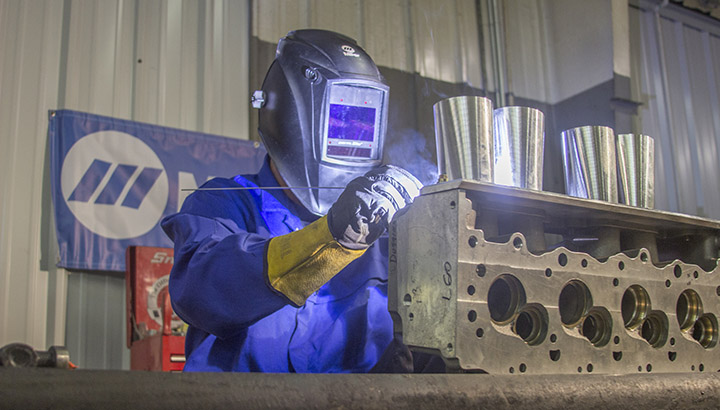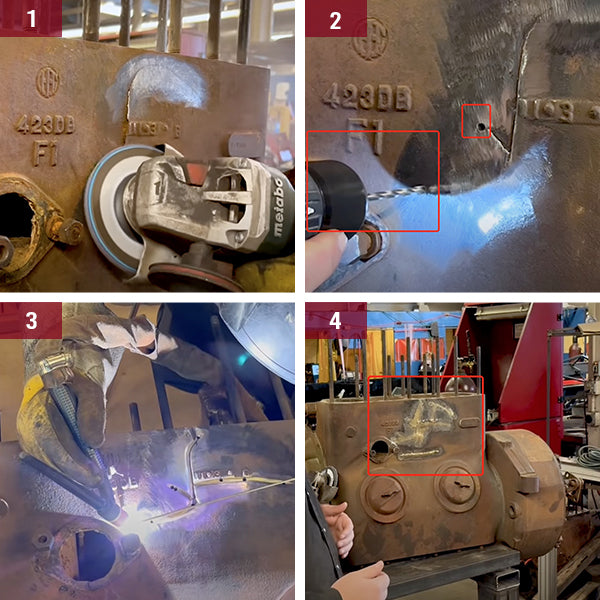Usual Welding Fixing Issues and How to Address Them Effectively
Welding repairs frequently come across a series of concerns that can threaten the integrity of the end product. Usual problems include poor infiltration, porosity, and misalignment, to name a few. Each issue presents distinct obstacles that need certain techniques for resolution. Recognizing these concerns is important for welders intending to enhance their abilities and results. This discussion will explore these usual welding repair service issues and reliable techniques to resolve them.
Insufficient Penetration
Inadequate penetration happens when the weld metal stops working to totally fuse with the base product, resulting in weak joints and potential architectural failings. This concern typically comes from inadequate heat input, incorrect electrode angle, or incorrect welding rate. Welders may come across insufficient penetration as a result of a miscalculation of the necessary parameters for a certain product density or type. Additionally, contamination on the base product's surface area can prevent reliable bonding, intensifying the trouble. To deal with poor infiltration, welders must ensure appropriate setups on their tools and keep a tidy work surface. Regular inspection of welds is recommended to recognize any kind of shortages early, permitting prompt improvements and the avoidance of compromised architectural stability in bonded assemblies.
Porosity
Porosity is a common flaw in welded joints that manifests as little gas bubbles entraped within the weld steel. This flaw can endanger the stability of the weld, causing decreased strength and prospective failure under stress and anxiety. Montana Mobile Welding and Repair Welding. Porosity typically arises from contamination, wetness, or inappropriate welding techniques, which permit gases to escape into the molten weld swimming pool. To resolve porosity, welders need to ensure proper surface area prep work, preserve a tidy working setting, and utilize suitable welding parameters. Additionally, selecting the ideal filler material and securing gas can minimize gas entrapment. Normal assessment and testing of welds can assist determine porosity early, guaranteeing prompt rehabilitative actions are taken, thereby maintaining the top quality and reliability of the bonded framework
Misalignment
Misalignment in welding can develop from various variables, consisting of inappropriate arrangement and thermal expansion. Understanding the source is necessary for reliable resolution. Numerous adjustment strategies are readily available to straighten parts and ensure architectural stability.
Reasons for Imbalance
Welding imbalance commonly originates from a variety of underlying issues that can jeopardize structural honesty. One primary cause is improper fit-up of components prior to welding, which can cause voids and unequal surfaces. Variants in thermal development during the welding procedure can also result in distortion, specifically if the products being signed up with have different coefficients of growth. Furthermore, poor securing and fixturing may stop working to hold components firmly in area, leading to activity throughout welding. Badly conserved tools, consisting of welding machines and tools, might introduce variances in the weld bead, more contributing to imbalance. Operator error, stemming from not enough training or experience, can also play a considerable duty in developing misaligned welds.

Improvement Strategies Readily Available
Dealing with misalignment effectively calls for a combination of rehabilitative strategies tailored to the details issues available. One usual method is making use of jigs or components to hold parts in the proper setting throughout welding, making sure constant positioning. Furthermore, pre-heating the materials can aid decrease distortion and improve fit-up. For considerable misalignment, mechanical realignment strategies, such as using hydraulic jacks or clamps, can be utilized to remedy the setting before welding. Post-weld warmth therapy might also be necessary to alleviate anxieties triggered by misalignment. Ultimately, cautious assessment and adjustment during the setup stage can stop imbalance concerns from becoming substantial problems, advertising a smoother welding process and improving total structural integrity.
Distortion
Distortion is a typical challenge in welding that can arise from various aspects, consisting of unequal home heating and cooling. Recognizing the causes of distortion is necessary for implementing effective prevention strategies. Resolving this concern not just enhances architectural integrity however likewise boosts the total high quality of the weld.
Sources of Distortion
When based on the intense warmth of welding, materials frequently undertake changes that can result in distortion. This phenomenon mainly occurs from thermal development and tightening during the welding process. As the weld location heats up, the material broadens; upon air conditioning, it gets, which can produce inner stress and anxieties. In addition, irregular home heating throughout a work surface can worsen these stress and anxieties, leading to warping or flexing. The sort of product likewise plays a considerable function; metals with varying thermal conductivity and coefficients of growth may respond in a different way, resulting in unforeseeable distortions. Additionally, bad joint style and poor fixturing can contribute to misalignment throughout welding, increasing the likelihood of distortion. Recognizing these causes is necessary for reliable welding fixing and prevention strategies.
Prevention Techniques
Effective prevention strategies for distortion throughout welding concentrate on regulating heat input and ensuring proper joint layout. Maintaining a constant warmth input helps to minimize thermal expansion and tightening, which can result in distortion. Utilizing strategies such as preheating the workpiece can additionally reduce the temperature level slope, advertising consistent heating. In addition, picking appropriate joint styles, such as T-joints or lap joints, can boost security and reduce stress focus. Applying correct fixturing to secure specialty welding the workpieces in position additionally help in keeping positioning during the welding procedure. Staggered welding sequences can disperse warmth extra uniformly, protecting against local distortion. By applying these methods, welders can greatly lower the possibility of distortion and improve the overall high quality of their welds.
Fracturing
Fracturing is an usual concern run into in welding fixings, usually arising from various factors such as inappropriate cooling rates, material option, or insufficient joint preparation. The occurrence of splits can considerably compromise the honesty of the weld, causing prospective failures during operation. To address this problem, welders should first assess the root creates, making sure that products work and properly picked for the specific application. In addition, controlling the cooling rate throughout the welding process is essential; rapid cooling can cause stress and anxiety and lead to fracturing. Proper joint layout and prep work likewise add to reducing the danger. Implementing these techniques can enhance weld quality and durability, eventually minimizing the chance of breaking in ended up weldments.

Insufficient Fusion
A substantial problem in welding fixings is insufficient combination, which takes place when the weld metal does not properly bond with the base product or previous weld passes - Montana Mobile Welding and Repair Belgrade. This problem can cause weaknesses in the joint, possibly jeopardizing the stability of the welded framework. Variables adding to insufficient blend consist of insufficient heat input, inappropriate welding method, and contamination of the surfaces being joined. To resolve this concern successfully, welders need to assure appropriate pre-weld cleaning and surface preparation, along with readjust their welding criteria to achieve sufficient penetration and fusion. Normal assessment during the welding process can also aid determine insufficient fusion early, permitting prompt rehabilitative procedures to improve the overall high quality of the weld
Overheating
While welding repair services can enhance architectural integrity, overheating offers a substantial challenge that can lead to product degradation. Excessive warmth during welding can alter the mechanical residential or try these out commercial properties of steels, resulting in lowered strength, enhanced brittleness, and warping. This phenomenon is especially critical in high-stress applications where architectural dependability is paramount. Determining getting too hot can involve aesthetic assessments for staining or distortion, in addition to keeping track of temperature throughout the welding procedure. To alleviate the risks related to overheating, welders must utilize suitable strategies, such as managing warmth input, readjusting traveling rate, and utilizing ideal filler products. Furthermore, implementing pre- and post-weld warmth treatments can aid restore product homes and boost the overall quality of the repair service, making certain long-term efficiency and safety and security.
Regularly Asked Concerns
What Are the Common Signs of a Welding Issue?

Exactly How Can I Check My Welds for Top quality?
To examine welds for high quality, one can make use of aesthetic examinations, ultrasonic testing, and radiographic approaches. Each strategy ensures structural honesty, identifies defects, and confirms adherence to specified criteria, ultimately improving the integrity of the bonded joints.
What Safety Precautions Should I Take While Welding?
When welding, one must focus on security by using appropriate personal safety tools, guaranteeing proper ventilation, securing combustible products visit this site away, maintaining a clean work area, and understanding surroundings to stop accidents and injuries.
Can I Fix a Weld Without Remodeling the Entire Joint?
Fixing a weld without remodeling the whole joint is feasible, depending upon the damages (Belgrade Welding). Techniques such as grinding, including filler product, or making use of a welding procedure can effectively address specific problems while protecting the surrounding structure
What Equipment Are Important for Efficient Welding Fixes?
Crucial devices for efficient welding fixings include a welding maker, cord brush, mill, safety equipment, clamps, and filler products. Each device plays an essential duty in making certain quality and safety throughout the repair process. Porosity commonly arises from contamination, wetness, or inappropriate welding techniques, which allow gases to get away right into the liquified weld swimming pool. Badly kept equipment, including welding makers and devices, might introduce disparities in the weld bead, additional contributing to imbalance. When subjected to the extreme warmth of welding, materials commonly go through adjustments that can lead to distortion. Breaking is a common concern encountered in welding repair work, frequently resulting from different factors such as inappropriate air conditioning rates, product selection, or poor joint preparation. A substantial concern in welding repair services is insufficient blend, which happens when the weld metal does not properly bond with the base material or previous weld passes.